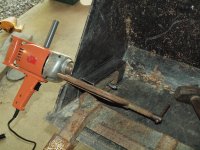TURN YOUR HEAT UP...
As an apprentice, I was working with a guy who specialized in steel buildings for oilfield skids. The panels were about 1/8" (10 or 12 gauge)and welded to the thicker checker plate on the skid with 1/8" 7018. I'd never done this type of welding before so the guy(not the nicest but seemed to like me) showed me how to do it. I wasn't used to it so tried to weld the conventional way but had nothing but problems. He got mad and said I don't know how to $#@%& weld...
I turned my heat down around 115 , held the rod at about a 60 deg. angle and even tried whipping the rod slightly to let the puddle cool so I wouldn't burn through. :ashamed:He told me again how to weld it. Turn your heat up to about 150 amps (really hot for 1/8" 7018):shocked:, point your rod almost straight down with the arc about about 1/8" away from the vertical panel and let molten puddle flow over and fuse the panel. Finished weld looked like it was done with an automatic machine!:cloud9:
I'll attempt this Arc but I'm gonna use 1/8" 7014. I think hot for that is 130 as my welder runs it pretty hot at 125.
